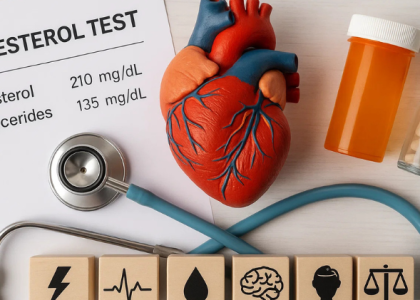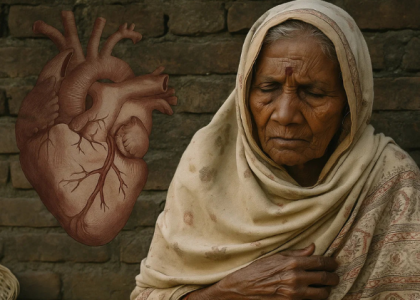Have you ever heard a story that goes something like this?
“My uncle walked every day, ate home-cooked food, never smoked, maintained a normal weight his whole life – and still had a heart attack at 45.”
Or perhaps:
“My mother has always been thin, does yoga regularly, but was just diagnosed with blocked arteries. How is this possible?”
If you’re South Asian (from India, Pakistan, Bangladesh, Sri Lanka, Nepal, Bhutan, or the Maldives), these stories might sound all too familiar. In our communities, heart disease often strikes people who appear outwardly healthy – creating confusion, fear, and sometimes a sense that heart attacks are simply “in our destiny.”
But there’s more to this story than meets the eye, and understanding it could save lives.
The Hidden Reality for South Asians
Research reveals a troubling pattern: South Asians develop heart disease at four times the rate of the general population and often a decade earlier than other ethnic groups. Even more surprising, this happens regardless of whether someone appears thin and healthy.
One cardiologist working with the MASALA study (Mediators of Atherosclerosis in South Asians Living in America) shares a common reaction: “I remember growing up as a second-generation immigrant in Texas and thinking, ‘Why are the aunties and uncles dying?'”
This question has led researchers to look beyond traditional risk factors to understand what’s happening in our community.
It’s Not Your Weight — It’s What’s Inside
For South Asians, traditional measures of health risk can be misleading. Here’s why:
1. The “Thin-Fat” Paradox
South Asians often have what researchers call the “thin-fat phenotype” – appearing slim on the outside while carrying dangerous fat deposits around internal organs.
Think of it this way: You can look perfectly fine in clothes or even have a normal BMI (Body Mass Index), but still have harmful fat wrapped around your liver, heart, and other vital organs. This type of fat, called visceral fat, is particularly dangerous for heart health.
In fact, a South Asian with a BMI of 23 (considered normal weight in most classifications) may have the same health risks as someone from another ethnic group with a BMI of 27 (considered overweight).
2. Inflammation — The Silent Danger
Visceral fat isn’t just storage space – it’s metabolically active tissue that releases inflammatory chemicals into your bloodstream. This chronic inflammation damages blood vessel walls over time, creating the perfect conditions for plaque buildup and eventual blockages.
A cardiologist at Stanford Health Care explains: “Body mass index in South Asians often falls into a thin-fat syndrome: People may have an acceptable BMI, but they also carry more weight in their abdomen, and that visceral fat is more likely to lead to a cardiovascular event.”
3. Genetics Tell a Complex Story
Our genetic makeup plays a significant role. Studies show that South Asians:
- Often have smaller blood vessels
- Tend to have higher levels of lipoprotein(a), a particularly dangerous form of cholesterol
- May have different metabolic responses to the same foods
- Are more likely to develop insulin resistance (a precursor to diabetes) at lower weights
A story from the American College of Cardiology recounts: “My father really took his health seriously. He started walking every day for an hour at a pace so brisk that his dog could barely keep up. He lost enough weight to no longer be classified as overweight. His blood sugar levels improved. Yet still, we were completely surprised to learn he had severe heart disease.”
Beyond the Physical: Stress and Lifestyle
Our bodies don’t exist in isolation from our experiences. For many South Asians, particularly immigrants, chronic stress creates another layer of risk:
- The challenges of immigration and adaptation
- Family and community pressures
- Cultural emphasis on achievement
- Work-life imbalance
All these factors can elevate stress hormones that further damage blood vessels and increase inflammation.
Additionally, certain aspects of South Asian diets and lifestyles contribute to risk:
- Traditional diets high in refined carbohydrates (white rice, white flour)
- Cooking methods that use clarified butter (ghee) and oils
- Lower levels of physical activity compared to other populations
- A cultural tendency to prioritize others’ needs over personal health
Real Stories from Our Community
Munaf Patel, a 43-year-old who regularly played cricket, basketball, and volleyball, couldn’t believe it when he had a heart attack at age 39. Despite his active lifestyle, he had his second heart attack just eight months after the first one. His father had died in his 40s from a heart attack, showing the powerful genetic component.
Anjana Srivastava joined the MASALA research study after seeing heart disease strike many relatives: “My grandfathers. My dad. My father-in-law. My brothers,” she recalled. “My grandmother died from it. I don’t think I even know a single family where someone doesn’t have heart disease.”
A cardiologist shares the story of his friend’s father: “He exercised regularly and was the poster child of cardiac health in his South Asian community. Yet he died suddenly from severe heart disease that no one knew he had.”
What Can We Do About It?
Understanding these unique risks is the first step toward prevention. Here are some specific actions that can help:
1. Know Your Numbers — But the Right Ones
Standard cholesterol tests may not tell the full story. Ask your doctor about:
- Advanced lipid testing (including lipoprotein(a))
- Inflammatory markers
- Insulin resistance tests
- Coronary calcium scores
And remember that “normal” thresholds might be different for South Asians.
2. Rethink Exercise
Exercise isn’t just about burning calories or losing weight – it’s about reducing inflammation and improving metabolic health. Focus on:
- Regular moderate exercise (at least 150 minutes weekly)
- A mix of cardio and strength training (muscle helps protect against insulin resistance)
- Consistency over intensity
3. Adjust Your Diet
Even vegetarian diets can be unhealthy if they’re high in refined carbs and dairy fats. Consider:
- Reducing white rice and refined flour portions
- Adding more vegetables, legumes, and whole grains
- Incorporating heart-healthy fats like nuts and olive oil
- Limiting sweets and fried foods
4. Manage Stress Proactively
Meditation, yoga, adequate sleep, and social connections all help reduce the harmful effects of chronic stress.
5. Start Early
For South Asians, heart disease prevention should begin in your 30s or even 20s, not after symptoms appear.
It’s Not About Weight, It’s About What’s Happening Inside
What makes this issue so challenging is that many of the warning signs aren’t visible. You can’t see visceral fat. You can’t see inflammation. You can’t see the early stages of arterial damage.
This is why seemingly healthy South Asians can have heart attacks that shock their families and communities. The outward appearance of health – being thin, active, or having normal routine blood work – can mask the internal processes that lead to heart disease.
The message isn’t meant to frighten, but to empower. By understanding the unique cardiovascular risks that South Asians face, we can take targeted actions to protect ourselves and our loved ones. Many medical centers now have specialized South Asian heart programs that address these specific risk factors.
Remember: It’s not about weight or appearance. It’s about what’s happening inside – and taking the right steps to keep your heart healthy for many years to come.
References
- American College of Cardiology. (2019). “Cover Story: South Asians and Cardiovascular Disease: The Hidden Threat.” Link
- American Heart Association. (2023). “Why are South Asians dying of heart disease? MASALA looks for answers.” Link
- UT Southwestern Medical Center. “What we know – and don’t – about South Asians’ heart disease risk.” Link
- Stanford Health Care. (2019). “Heart Disease in South Asians Q&A.” Link
- Chicago Tribune. (2019). “South Asians make up 60 percent of heart disease patients.” Link
- Franciscan Health. (2024). “South Asians And Heart Disease – Know the Risk, Take Control.” Link
- NBC News. (2017). “Asians, blacks, Hispanics have more heart disease risks at normal weight: study.” Link
- Circulation. “South Asians and Cardiovascular Risk.” Link




